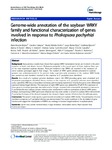Use este identificador para citar ou linkar para este item:
http://www.alice.cnptia.embrapa.br/alice/handle/doc/1003866Registro completo de metadados
| Campo DC | Valor | Idioma |
|---|---|---|
| dc.contributor.author | BENCKE-MALATO, M. | pt_BR |
| dc.contributor.author | CABREIRA, C. | pt_BR |
| dc.contributor.author | WIEBKE-STROHM, B. | pt_BR |
| dc.contributor.author | BÜCKER-NETO, L. | pt_BR |
| dc.contributor.author | MANCINI, E. | pt_BR |
| dc.contributor.author | OSORIO, M. B. | pt_BR |
| dc.contributor.author | HOMRICH, M. S. | pt_BR |
| dc.contributor.author | TURCHETTO-ZOLET, A. C. | pt_BR |
| dc.contributor.author | CARVALHO, M. C. C. G. de | pt_BR |
| dc.contributor.author | STOLF, R. | pt_BR |
| dc.contributor.author | WEBER, R. L. M. | pt_BR |
| dc.contributor.author | WESTERGAARD, G. | pt_BR |
| dc.contributor.author | CASTAGNARO, A. P. | pt_BR |
| dc.contributor.author | ABDELNOOR, R. V. | pt_BR |
| dc.contributor.author | MARCELINO-GUIMARÃES, F. C. | pt_BR |
| dc.contributor.author | MARGIS-PINHEIRO, M. | pt_BR |
| dc.contributor.author | BODANESE-ZANETTINI, M. H. | pt_BR |
| dc.date.accessioned | 2014-12-29T11:11:11Z | pt_BR |
| dc.date.available | 2014-12-29T11:11:11Z | pt_BR |
| dc.date.created | 2014-12-29 | pt_BR |
| dc.date.issued | 2014 | pt_BR |
| dc.identifier.citation | BMC Plant Biology, v. 14, n. 1, article 236, Sept. 2014. | pt_BR |
| dc.identifier.issn | 1471-2229 | pt_BR |
| dc.identifier.uri | http://www.alice.cnptia.embrapa.br/alice/handle/doc/1003866 | pt_BR |
| dc.description | Background: Many previous studies have shown that soybean WRKY transcription factors are involved in the plant response to biotic and abiotic stresses. Phakopsora pachyrhizi is the causal agent of Asian Soybean Rust, one of the most important soybean diseases. There are evidences that WRKYs are involved in the resistance of some soybean genotypes against that fungus. The number of WRKY genes already annotated in soybean genome was underrepresented. In the present study, a genome-wide annotation of the soybean WRKY family was carried out and members involved in the response to P. pachyrhizi were identified. Results: As a result of a soybean genomic databases search, 182 WRKY-encoding genes were annotated and 33 putative pseudogenes identified. Genes involved in the response to P. pachyrhizi infection were identified using superSAGE, RNA-Seq of microdissected lesions and microarray experiments. Seventy-five genes were differentially expressed during fungal infection. The expression of eight WRKY genes was validated by RT-qPCR. The expression of these genes in a resistant genotype was earlier and/or stronger compared with a susceptible genotype in response to P. pachyrhizi infection. Soybean somatic embryos were transformed in order to overexpress or silence WRKY genes. Embryos overexpressing a WRKY gene were obtained, but they were unable to convert into plants. When infected with P. pachyrhizi, the leaves of the silenced transgenic line showed a higher number of lesions than the wild-type plants. Conclusions: The present study reports a genome-wide annotation of soybean WRKY family. The participation of some members in response to P. pachyrhizi infection was demonstrated. The results contribute to the elucidation of gene function and suggest the manipulation of WRKYs as a strategy to increase fungal resistance in soybean plants. | pt_BR |
| dc.language.iso | eng | eng |
| dc.rights | openAccess | eng |
| dc.title | Genome-wide annotation of the soybean WRKY family and functional characterization of genes involved in response to Phakopsora pachyrhizi infection. | pt_BR |
| dc.type | Artigo de periódico | pt_BR |
| dc.date.updated | 2014-12-30T11:11:11Z | pt_BR |
| dc.subject.thesagro | Soja | pt_BR |
| dc.subject.nalthesaurus | Soybeans | eng |
| dc.format.extent2 | 18 p. | pt_BR |
| riaa.ainfo.id | 1003866 | pt_BR |
| riaa.ainfo.lastupdate | 2014-12-30 | pt_BR |
| dc.identifier.doi | 10.1186/s12870-014-0236-0 | pt_BR |
| dc.contributor.institution | MARTA BENCKE-MALATO, UFRGS; CAROLINE CABREIRA, UFRGS; BEATRIZ WIEBKE-STROHM, UFRGS; LAURO BÜCKER-NETO, UFRGS; ESTEFANIA MANCINI, Instituto de Agrobiotecnologia Rosario SA; MARINA B. OSORIO, UFRGS; MILENA S. HOMRICH, UFRGS; ANDREIA CARINA TURCHETTO-ZOLET, UFRGS; MAYRA C. C. G. DE CARVALHO, CNPSO - estagiária; RENATA STOLF, CNPSO - estagiària; RICARDO L. M. WEBER, UFRGS; GASTÓN WESTERGAARD, Instituto de Agrobiotecnologia Rosario SA; ATÍLIO P. CASTAGNARO, Estación Experimental Agroindustrial Obispo Colombres (EEAOC); RICARDO VILELA ABDELNOOR, CNPSO; FRANCISMAR CORREA MARCELINO-GUIMARÃES, CNPSO; MÁRCIA MARGIS-PINHEIRO, UFRGS; MARIA HELENA BODANESE-ZANETTINI, UFRGS. | pt_BR |
| Aparece nas coleções: | Artigo em periódico indexado (CNPSO)  | |
Arquivos associados a este item:
| Arquivo | Descrição | Tamanho | Formato | |
|---|---|---|---|---|
| GenomewideannotationofthesoybeanWRKYfamilyandfunctionalcharacterizationofgenesinvolvedinresponsetoPhakopsorapachyrhiziinfection.pdf | 3,18 MB | Adobe PDF |  Visualizar/Abrir |









